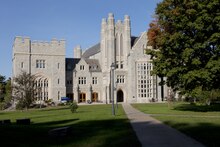
Back التعليم العالي في الولايات المتحدة Arabic ABŞ universitetləri Azerbaijani Tertiärer Bildungsbereich in den Vereinigten Staaten German Enseñanza universitaria en Estados Unidos Spanish آموزش عالی در ایالات متحده آمریکا Persian Korkeakoulutus Yhdysvalloissa Finnish Enseignement supérieur aux États-Unis French アメリカ合衆国の高等教育 Japanese 미국의 고등 교육 Korean Høyere utdanning i USA NB
| This article is part of a series on |
| Education in the United States |
|---|
| Summary |
| Curriculum topics |
| Education policy issues |
| Levels of education |
|
|


In the United States, higher education is an optional stage of formal learning following secondary education. It is also referred to as post-secondary education, third-stage, third-level, or tertiary education. It covers stages 5 to 8 on the International ISCED 2011 scale. It is delivered at 3,931 Title IV degree-granting institutions, known as colleges or universities.[1] These may be public or private universities, research universities, liberal arts colleges, community colleges, or for-profit colleges. U.S. higher education is loosely regulated by the government and by several third-party organizations.[2]
Post secondary (college, university) attendance was relatively rare through the early 20th century. Since the decades following World War II, however, attending college or university has been thought of as "a rite of passage" to which the American Dream is deeply embedded.[3] Nonetheless, there is a growing skepticism of higher education in the U.S. and its value to consumers.[4][5] U.S. higher education has also been criticized for encouraging a financial preference for the most prestigious institutions (e.g., Ivy League schools) over less selective institutions (e.g., community colleges).[6]
In 2022, about 16 million students—9.6 million women and 6.6 million men—enrolled in degree-granting colleges and universities in the U.S. Of the enrolled students, 45.8% enrolled in a four-year public institution, 27.8% in a four-year private institution, and 26.4% in a two-year public institution (four-years is the generally expected time to complete a bachelor's degree, and two-years, an associates degree).[7] College enrollment peaked in 2010–2011 and is projected to continue declining or be stagnant for the next two decades.[8][9][10][11][12][13][needs update]
Strong research funding helped elite American universities dominate global rankings in the early 21st century, making them attractive to international students, professors and researchers.[14] Higher education in the U.S. is also unique in its investment in highly competitive NCAA sports, particularly in American football and basketball, with large sports stadiums and arenas adorning its campuses and bringing in billions in revenue.[15]
- ^ Cite error: The named reference
institutionswas invoked but never defined (see the help page). - ^ Nataša Bakić-Mirić; Davronzhon Erkinovich Gaipov (February 27, 2015). Current Trends and Issues in Higher Education: An International Dialogue. Cambridge Scholars Publishing. pp. 154–. ISBN 978-1-4438-7564-6.
- ^ Cite error: The named reference
:0was invoked but never defined (see the help page). - ^ Brenan, Megan (July 11, 2023). "Americans' Confidence in Higher Education Down Sharply". Gallup. Retrieved July 19, 2023.
- ^ Belkin, Douglas (March 31, 2023). "Americans Are Losing Faith in College Education, WSJ-NORC Poll Finds". Wall Street Journal. Retrieved July 19, 2023.
- ^ Fain, Paul. "Race and Inequity". www.insidehighered.com. Inside Higher Education. Retrieved September 13, 2023.
- ^ "Spring 2022 Enrollment Estimates" (PDF). National Student Clearinghouse Research Center. May 2022.
- ^ Jaschik, Scott (January 7, 2018). "New book argues most colleges are about to face significant decline in prospective students". Inside Higher Ed.
- ^ "Why Is Undergraduate College Enrollment Declining?". NPR.
- ^ "The Condition of Education" (PDF). National Center for Education Studies. May 2018. Retrieved April 2, 2019.
- ^ Redden, Elizabeth (May 30, 2018). "Intensive English Enrollments in U.S. Drop 20%". Inside Higher Ed.
- ^ "Fall 2018 Overall Postsecondary Enrollments Decreased 1.7 Percent from Last Fall". National Student Clearinghouse. December 13, 2018. Archived from the original on March 29, 2019. Retrieved March 21, 2019.
- ^ "Projections of Education Statistics to 2027" (PDF). National Center for Education Studies. February 2019. Retrieved April 2, 2019.
- ^ Phil Baty (September 16, 2010). "The World University Rankings: Measure by measure: the U.S. is the best of the best". TSL Education Ltd. Retrieved December 12, 2012.
- ^ Vedder, Richard. "The Three Reasons College Sports Is An Ugly Business". Forbes.